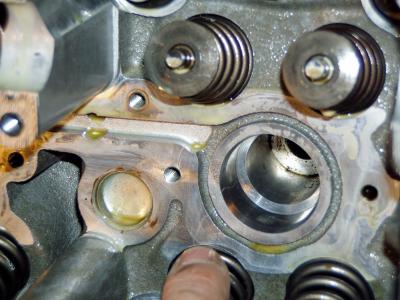I thought I would provide an update on the solution to the intermix/cracked head problem on my 2000 996. For those of you who haven’t seen the previous threads, last September, 8 months after the expiration of my EasyCare extended warranty my car developed an intermix problem, with significant amounts of oil in the coolant and coolant in the oil. Initially I tried to change the oil and top off the coolant to see how long before the intermix reoccurred, but it seemed to happen immediately (although some of this might have been residual contaminated fluids in the engine and cooling system).Therefore it seemed that a new engine would be required, and with the economy limiting the budget I parked the car for the winter.
This spring I started work on the car, first checking the oil cooler for any problems, but quickly determined that this was not the source of the intermix. Then I dropped the engine and begin disassembling it. Soon I found the crack in cylinder head 1-3, cylinder 1 at the inner exhaust valve seat, which you can see in the photo above. This seems to be a very common problem, and the most common area for cracks in the heads of M96 engines.
Now I considered four or five alternatives, a remanufactured/rebuilt engine, a used engine, a used cylinder head, a new cylinder head or fixing the crack in the head I had.
The replacement of the engines was out of my budget. Porsche now wants over $12,000 plus a core for a remanufactured engine (this is through Sunset or Suncoast, the list is much higher), and only warranties the engine if it is installed by a dealer. I wanted to stay married so that option was quickly ruled out. Looked at some sources for rebuilt engines, but they seem to be $7,000+ and somewhat of an unknown quantity. Used engines seem to be $5,000+ and are also an unknown quantity.
I checked out the cost of a new head, which list for about $2,700, and Sunset and Suncoast were about $2,400, and the 1-3 heads were in Germany so over a month away. The parts department at Suncoast did lead me to a dealer in the Chicago area who appears to have the only new 1-3 head in the states, and would let it go for approx $2,400. But I found out that Porsche only warranties the head if it is installed by a dealer. Seemed like a lot of money for a head without any warranty. So I scratched that alternative.
Next I tried to find a good used 1-3 head, but they are very scarce. Several wreckers had 4-6 heads but no 1-3 heads. Found a set of heads through a member in Florida at an incredible price, but I asked the member, who is a Porsche tech to check the heads for cracks. He said he had never seen a cracked head but would gladly check the heads. A little penetrating dye showed that the 1-3 head was cracked a cylinder #1, inner exhaust valve seat. Found another set, but when they were checked 1-3 was also cracked. Do we see a pattern here? Found another set in NY, but they were from an independent/Ebay seller who could not tell if they were cracked. He said he would refunds the money if they were cracked, but we could not agree on a price, and I was worried on getting the money back. Cracks in the 1-3 heads seem to be far too common. I spoke to Jake Raby and he told me that in a 10 day period they tore down 5 engines for big bore upgrades, and 4 had cracked heads, although only one had developed an intermix problem. But we all know that cracks don’t get better, and it is probably only a matter of time until the other cracked heads would lead to problems. Jake said he would certainly not use a cracked head so he was sitting on the engines until a solution could be found.
So I decided to have the head repaired. Kind of figured that with so many heads cracking in the same area maybe a repaired head would actually be stronger. Sent the Head to Costa Mesa R&D, where they have experience with repairing these heads. Here is a picture of the repaired head, it is supposed to be delivered to me on Friday and I hope to be back on the road in the next week or so. The cost of the repair was $503, including a valve job and drilling out a frozen bolt on the cam sensor and putting in a coil, plus about $30 shipping in each direction.
I am keeping my fingers crossed that this is the solution to my problem. Wish me luck!







